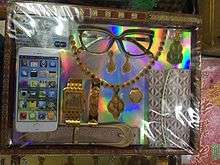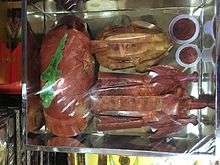Papier-mache offering shops in Hong Kong

Traditional papier-mache offering shops in Hong Kong sell papier-mache offering items for sacred purposes[1] and for festival-celebration purposes, the popularity started since the 1940s. Nowadays, the demand of papier sacred products are lowering and thus papier-mache shops and the entire papier-mache industry are facing declination.[2]
History of Papier mache shop in Hong Kong
Papier-mache offering shops started popping up in Hong Kong since 1940. From 1940, there were high demand of papier maches and the papier-mache industry was prosperous, shops were basically ran by the whole family that they manufactured and sold the papier-mache products all by their own.[3] In the 1950s, the Communist Party in China started to simplify funeral services through education, persuasion and step-by-step measures,[4] following to the cultural revolution started from 1960, the Communist Party promoted simplism,[5] they simplified traditional cultures and most of the traditional funeral rites were being dissuaded in mainland. This led to the flocking in of mainland papier-mache shop-owners to Hong Kong to continue their business. After 1980, Hong Kong transformed into an International Financial Centre which promoted knowledge-based economy. People were not willing to work in papier-mache sectors, this gradually led to the declination of papier-mache industry in Hong Kong. Nowadays in Hong Kong, not only the demand of papier-mache products is low, but over one-ninth of papier-mache products sold by local papier-mache offering shops are also imported from the mainland China,[2] local papier-mache offering shops doing their own production are not common nowadays.
Papier-mache products during different occasions and target customers
There are generally two types of usage of papier-mache products, festival papier-mache for celebration and for funeral use. Papier-mache offering shops target their customers occasionally, they provided various papier-products according to different festivals and occasions. For people who consecrate offerings, most of them are Taoism and Buddhism.
Festival using paper-mache offerings


In Chinese New Year, shops provide paper money, joss sticks, Fai Chun and lighted red candles for good luck inscriptions.[6] Paper offerings are in demand at Ghost Festival,[7] various offerings such as incenses, joss paper accessories, altar candles, paper-mache form of material items (i.e. golds, clothes, bank notes) or other goods for the visiting spirits of ancestors, those all have a strong footing in paper offerings market. Candles in wooden bowls are placed on street corners or along rivers to guide wandering spirits to the feasts prepared for them. Shops provide joss paper,accessories paper and incense, selling to the public to sacrifice their ancestors in Qingming Festival.[8] In the Mid-Autumn Festival and Lantern Festival, shops sell candles and paper lanterns, which are used for celebration Families are willing to buy those stuff for children in the Mid-Autumn Festival.[9]
Funeral using paper-mache offerings
Chinese funeral (Taoist funeral), is the occasion which uses the paper offerings most. Paper horse and paper goat is a must in the funeral ceremony.[10] Those offerings are used for releasing souls from purgatory, fulfilling the dead daily needs in the underworld,[11] such as paper currency, clothes, food, houses, and transports.Nowadays, products of paper offerings for funerals are near life size , for example, TV, iPhone or other electronic products are one of the paper mache offerings. This is a mixture of modern and ancient civilization. In this case, the target customers are people who held the Taoism funeral.
The famous papier-mache shops in Hong Kong
Papier-mache offering shops with long history in Hong Kong are mostly clustered together in Queen's Road West and Queen’s Road Central. Bo Wah Paper Craft (寶華紮作) and Chau Zi Paper Craft (秋記紮作) are two well-known papier-mache offering shops because of their long history.
Bo Wah Paper Craft (寶華紮作)
Bo Wah Paper Craft (寶華紮作) is established in 1963 and located in Sham Shui Po.[12] The owner used to make traditional papier-mache like lion head for Chinese New Year, but Au Yeung Bing Chi, the son of the owner, have changed the style of papier-mache from traditional to modish in order to cater for the modern society and to create a new trend. Papier-mache can be customized in Bo Wah, creative papier-mache products such as Stormtrooper in Star Wars and specific bones of human skeleton are available in the shop.[13]
Chau Zi Paper Craft (秋記紮作)
Chau Zi Paper Craft (秋記紮作), established in 1930 and located in Central, is one of the oldest papier-mache shops in Hong Kong. The owner Chan Kui Chau is a well-known Hong Kong papier-mache maker who made traditional papier-mache products such as trotting horse lamp. Chau Zi attracts tourists from all over the world coming to visit, order and explore traditional Chinese papier-mache products.[14]
Comparison between different Papier-mache offering shops among the world
Papier-mache is a tradition among Asia, besides China and Hong Kong people, papier-mache offering shops are even being set-up in Japan, Vietnam and Malaysia with their unique cultures.
Japan
People would make the papier mache by themselves since Tang dynasty.[15] Yet, due to the economic development, people started to set up shops afterwards. Unlike Hong Kong, the paper mache shops in Japan sells traditional paper products like orizuru (Japanese paper crane) , omamori and Japanese traditional dolls for bowing and making wishes in the shrine and temples.
Vietnam
In Vietnam, the Hàng Mã Street located in Hanoi, has been selling paper goods for more than 500 years.[16]
Western countries
Shops are even set up in Western countries like the USA or United Kingdom by Chinese immigrant. For example, Mulberry Street in America, also known as Chinatown, there are also papier-mache selling shops which are similar with those in Hong Kong. They serve the Chinese who are living there to celebrate Chinese festivals.[17]
Interior design and architectural style
Papier-mache shops in Hong Kong are usually designed in traditional Chinese style without fancy decoration. The layout seems to be disorganised but the goods are arranged orderly. A large tablet placed on top of the door with the name of the shop written in golden colour, yellow colour or red colour, around with some Chinese lanterns for decoration. Some shelves are put outside the shops for displaying products. For the setting, some simple closets are placed all around the shop with variety of products on it. A glass case table forms a corner for the shop owner. Generally there are tables placed in the middle of the shop, with a lot of package of foss paper and papier-mache putting on them for ancestor worship, which sorted out by plastic baskets or cartons. The 3D papier-maches are wrapped in plastic bags and being hanged inside the shop.[18] During some traditional Chinese festivals such as the mid-autumn festival, the festive products will also be wrapped in plastic bags and being hanged outside the shop to attract customers.
References
- ↑ Siu, Kin Wai. "Lanterns of the Mid-Autumn Festival: A Reflection of Hong Kong Cultural Change". The Journal of Popular Culture. 33 (2): 67–86. doi:10.1111/j.0022-3840.1999.3302_67.x.
- 1 2 "紙紮業在香港的歷史". 2009.
- ↑ "紙紮進化論".
- ↑ ZHANG, WEIMIN (1983-10-23). "China buries old traditions". South China Morning Post (1946-Current) [Hong Kong].
- ↑ 黃, 延敏 (June 2013). "破四舊運動的發展脈絡" (PDF). Chinese University of Hong Kong.
- ↑ Li, Ellen (1 Aug 2010). Chinese Festival. Nabu Press. ISBN 1176542486.
- ↑ Deutsch, Lauren (Spring 2010). "Up in Smoke Chinese Joss Paper Offerings".
- ↑ "Chinese offerings go up in smoke for dear ancestors". Malaymail Online. 5 April 2015.
- ↑ SIU, Lin Wai (March 2004). "Lanterns of the Mid‐Autumn Festival: A Reflection of Hong Kong Cultural Change". The Journal of Popular Culture. 33: 67–86. doi:10.1111/j.0022-3840.1999.3302_67.x.
- ↑ Li, Shuang (1993). "The Funeral and Chinese Culture". The Journal of Popular Culture. 27 (2): 113–120. doi:10.1111/j.0022-3840.1993.113555.x.
- ↑ LAI, Chi Tim (2006). "Making Peace with the Unknown: A Reflection on Daoist Funerary Liturgy". Death, Dying and Bereavement: A Hong Kong Chinese Experience. 5: 87–92.
- ↑ "Bo Wah Paper Craft - Bonding of Father and Son". Hong Kong Jockey Club HULU. Hong Kong Jockey Club HULU.
- ↑ "深水埗潮爆紙紮鋪 星球大戰都整到". Next Media. 2015-03-17.
- ↑ 林, 佩婷 (2010-08-06). "代 Cult2:八十前 老師傅紮足70年". Apple Daily. Next Media.
- ↑ Ba, Bai Shan; Kang, Jia Xun. 一看就懂,誰都能做紙公仔 (Ways to make a papier mache). Shu Chuan Publishing House.
- ↑ Huyền Minh, Lê Thị. "How to preserve the Old Quarter". Vietnam Government Web Portal. Vietnam Government Portal.
- ↑ 黃, 偉江. "清明紙紮品熱賣 (Papier-mache products become hot items in Ching Ming Festival)". Sing Tao Daily. Sing Tao Ltd.
- ↑ 胡, 燕青 (2007). 彩店 - 胡燕青散文集. Hong Kong: Infolink Publishing.